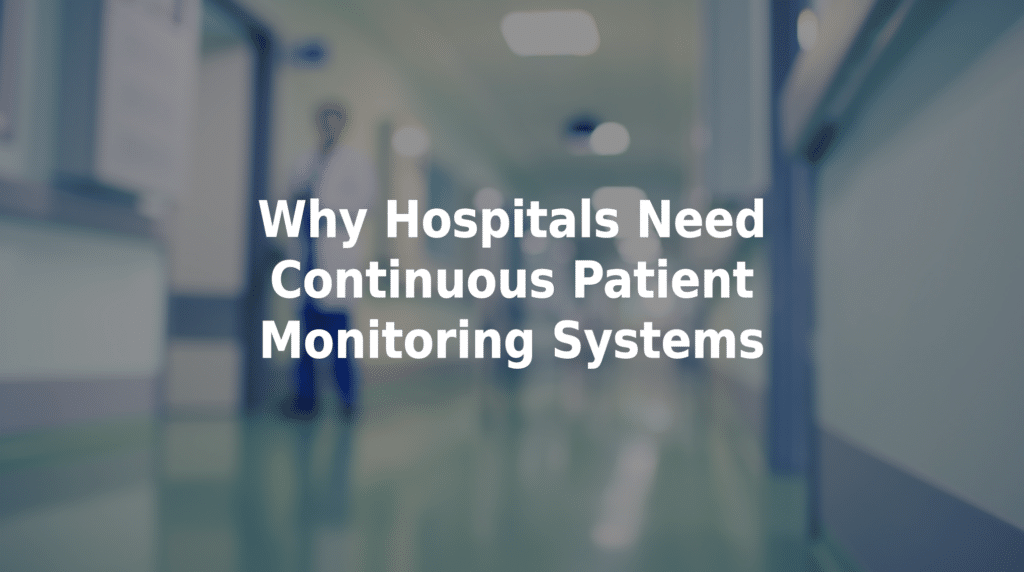Why Hospitals Need Continuous Patient Monitoring Systems
Improving patient outcomes while managing operational efficiency is a top priority for hospital administrators. One of the most effective strategies to achieve these goals is the use of wearable sensors to monitor patient vitals. Understanding why hospitals need continuous patient monitoring systems is essential for identifying gaps in care, preventing readmissions, and supporting value-based models. TriageLogic offers a turnkey remote patient monitoring (RPM) platform that enables hospitals to oversee patient health in real time — both during admission and after discharge — to deliver more proactive, data-driven results.
The Case for Continuous Monitoring in Hospital Settings
Hospitals traditionally rely on intermittent in-person assessments that may miss early signs of patient deterioration. This reactive model increases the risk of complications, particularly for high-risk patients with chronic conditions or recent surgeries.
Conversely, continuous monitoring systems provide real-time tracking of vital signs and biometric data, allowing care teams to:
- Identify warning signs sooner.
- Reduce time to intervention.
- Avoid unnecessary ICU admissions or readmissions.
- Improve clinical documentation and decision-making.
TriageLogic’s Continuous Monitoring Model
Our RPM solution helps teams monitor patients post-discharge for continuity of care and at-home recovery. Our system includes:
- Wearable sensors that meet HIPAA requirements and can track key vitals like blood pressure, heart rate, oxygen saturation, and glucose.
- 24/7 clinical triage support that responds to sensor alerts and escalates care when needed.
- Customizable alerts and thresholds based on patient-specific conditions and risk levels.
- The ability to integrate with hospital EHR systems for seamless and accurate documentation.
By combining technology with human clinical oversight, TriageLogic creates a hybrid monitoring model that enhances safety and responsiveness.
Benefits for Hospitals Using Continuous Monitoring Systems
Hospitals that implement continuous patient monitoring systems can expect several measurable benefits.
- Early Detection of Worsening Symptoms. Vital changes in cardiac or respiratory function are often detected hours before visible symptoms appear. Continuous monitoring allows for early intervention, improving patient outcomes.
- Fewer Readmissions. By monitoring patients after discharge, hospitals can catch complications early and reduce unnecessary returns — especially for high-risk groups like those with COPD, CHF, or diabetes.
- Improved Operational Efficiency. Automated alerts and nurse triage workflows streamline staff response times and reduce the burden of manual check-ins, allowing nurses and physicians to prioritize critical cases.
- Better Performance in Value-Based Care Programs. Hospitals can use RPM data to improve clinical metrics, support shared savings programs, and demonstrate quality improvements to payers and regulators.
Best Practices for Implementing Continuous Monitoring
To successfully implement RPM, hospital administrators should perform the following.
- Identify patient populations for RPM eligibility (e.g., recent discharges, elderly patients, chronic conditions).
- Incorporate clinical triage oversight to manage alerts and avoid alarm fatigue.
- Integrate monitoring data with existing workflows for real-time visibility.
- Engage patients and caregivers with onboarding and support to ensure compliance.
TriageLogic can assist your hospital with RPM implementation, from program setup to staff training and ongoing clinical support.
Explore Continuous Monitoring Solutions With TriageLogic
Hospitals that invest in continuous patient monitoring systems are better equipped to deliver proactive care, reduce readmissions, and excel in value-based care initiatives. TriageLogic’s RPM platform is designed to help you achieve those goals with flexible, clinically driven tools.
Want to see how this solution could be used by your team? Contact us today to learn more and schedule a demo!

